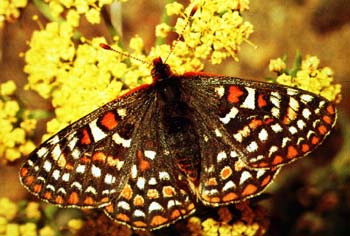![[Metroactive News&Issues]](/gifs/news468.gif)
[ San Jose | Metroactive Central | Archives ]
 Photograph by George Sakkestad Game of Checkerspot The bay checkerspot butterfly flutters only in this county By Jim Rendon Name: Euphydroayas editha bavensis Status: Threatened Natural Habitat: Bay Area hillsides Last Stand: Coyote Ridge from Silver Creek to the Kirby Canyon landfill Reason for Demise: The San Jose City Council's inability to stick to the General Plan and stop approving hillside development in Evergreen, on the northernmost edge of Coyote Ridge PAUL EHRLICH, the biology professor whose 1968 book, The Population Bomb, spooked a generation into using birth control, cut his teeth on a butterfly. Ehrlich began his Stanford career studying the bay checkerspot in Stanford's Jasper Ridge biological preserve. Just four decades later, in its own population implosion, the butterfly has completely disappeared from there. Though the brown, black and white spotted butterfly could once be found in all five Bay Area counties, it's now found only in this county, and almost exclusively in the Diablo range on the eastern side of the valley. Most of the population is now isolated on a reserve near the Kirby Canyon landfill off Route 101 near Morgan Hill. The reserve, set up as part of the arrangement to create the landfill, at one time hosted hundreds of thousands of butterflies. Now there may be only be thousands of butterflies there, says Dennis Murphy, who worked with Ehrlich as a graduate student at Stanford. Part of the decline is due to the weather. The butterfly lays eggs over a short period in the late winter. The larvae hatch, eat like mad until the dry season, then go dormant until the next rain. When the fall rains come, they feed again, then hatch from cocoons in the spring as the brightly spotted butterfly. After 10 days or so, they die. Timing can be everything for the butterfly. In the event of a wet year, they may lay eggs later, which delays the hatching time of the larvae. If they hatch too late in the spring, there will not be enough food for them to eat and they will not be able to survive the long dry season. Since a female lays more than 1,000 eggs, a few good years in a row can lead to huge population growth. A few bad years can be devastating. With a population that varies so dramatically, habitat is vital, Murphy says. The checkerspot relies on a few plant species for survival, species which themselves are endangered. One of those species is the Santa Clara Valley dudleya, a flowering succulent. It is found primarily on the eastern hills. The flower has been able to survive the onslaught of more tenacious imported grass species because those grasses cannot survive on the harsh serpentine soils that the dudleya requires. The butterfly larvae eat the dudleya, and the chemical makeup of the plants, which have adapted to survive on the uninviting soil, makes the butterfly and the larvae poisonous to birds and other predators, thereby further ensuring their survival. But more than bad weather is impacting the butterfly. Every year tons of smog is pumped into the air over Silicon Valley. All that yellow-gray pollution blows east and settles on the hills of the Diablo range. Smog contains nitrogen, the most basic fertilizer. Over time the naturally inhospitable serpentine soils of the Diablo range are becoming fertilized, making them more inviting to the grasses that have taken over the rest of the valley. The plants the butterflies need are losing out again. Ironically, cattle, the bane of environmentalists for decades, may provide an answer. Cows prefer invasive grasses, clearing them out of the way for species like the dudleya that support the butterfly. But without management, the hills that once naturally supported the butterfly are less and less able to do the job. "The real message here is that not building on the butterfly's habitat is not enough to save the species. You can't just put a fence around the habitat; you've got to deal with the issue of insidious takeover of grassland by non-native species," Murphy says. [ San Jose | Metroactive Central | Archives ]
|
From the November 24-December 1, 1999 issue of Metro, Silicon Valley's Weekly Newspaper.
Copyright © 1999 Metro Publishing Inc. Metroactive is affiliated with the Boulevards Network.
For more information about the San Jose/Silicon Valley area, visit sanjose.com.